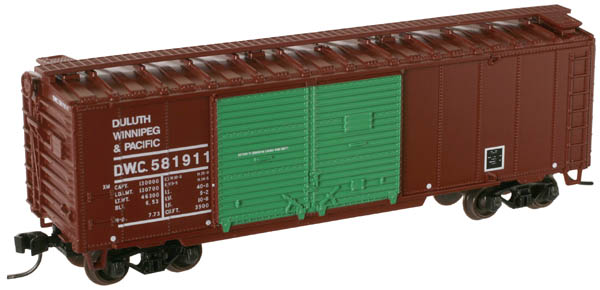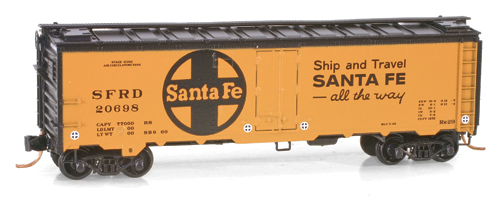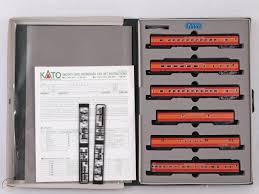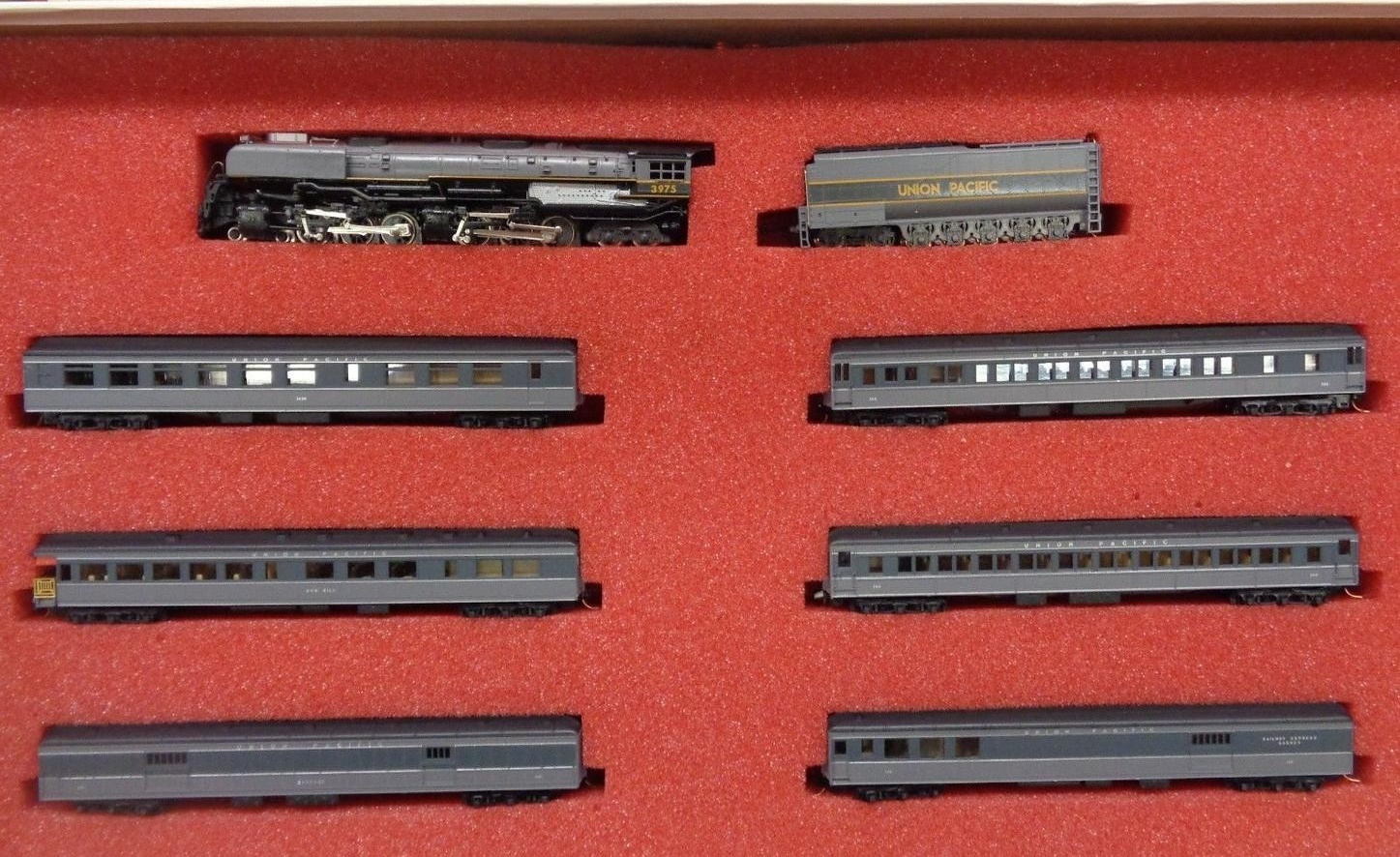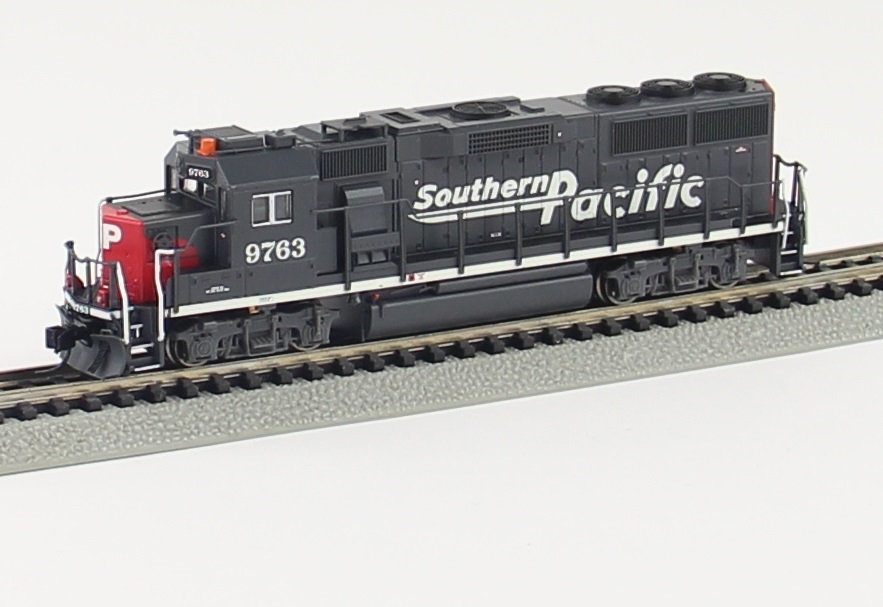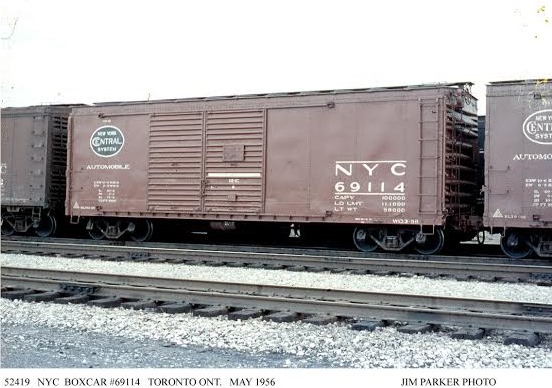Model Information: This model is the Chinese retooling that Atlas made to replace the 1967 vintage Roco-made version of the 40 foot double door boxcar. This model first appeared in 2009. The newer version being 40 years younger, shows better detail and nice crisp lettering. The model features Youngstown doors and Improved Dreadnaught ends. Atlas produced 6 releases of this new tooling between 2009 and 2015. This model is currently (2017) part of the Atlas Trainman line. Another re-release came out ion March of 2018.
Prototype History: Steel boxcars became a common site in the post-WWII period (also known as the transition era). Steel construction resulted in a lighter, lower-maintenance car that was less expensive to acquire and operate. The economies of scale that happened during the war along with a cessation of orders from the military resulted in a plentiful, inexpensive source of metal and aluminum for the railcar manufacturers which in turn led a complete replacement of the aging wood-sheathed fleets with new steel cars.
One common variation of the ubiquitous 40 foot steel boxcar was the double-sliding door variation. This configuration allowed for easier loading and unloading of larger objects. A common use-case was automobile transportation. In the modern era, we are used to seeing huge autoracks with up to three levels of cars stacked one on top of the other, but back during the transition era, these beasts did not exist, and car were loaded onto boxcars with this special door configuration. Although this type of car was used for other bulky objects, they were frequently labeled 'Automobile' on the sides to clearly indicate to potential customers that the railroad had the capacity to transport this large bulky objects with their fleet.
One common variation of the ubiquitous 40 foot steel boxcar was the double-sliding door variation. This configuration allowed for easier loading and unloading of larger objects. A common use-case was automobile transportation. In the modern era, we are used to seeing huge autoracks with up to three levels of cars stacked one on top of the other, but back during the transition era, these beasts did not exist, and car were loaded onto boxcars with this special door configuration. Although this type of car was used for other bulky objects, they were frequently labeled 'Automobile' on the sides to clearly indicate to potential customers that the railroad had the capacity to transport this large bulky objects with their fleet.
Road Name History: 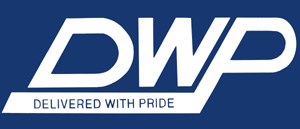 The DW&P was the result of the 1909 reorganization of the Duluth Rainy Lake & Winnipeg Railway. Under the control of the Canadian Northern, the DW&P completed their 167 mile line from Duluth, Minnesota, northwest to Fort Frances, Ontario on the U.S.-Canada border in 1912. At Fort Frances they connected with CNor’s mainline between Winnipeg and Thunder Bay. Canadian Northern became part of Canadian National in 1918 and control of DW&P passed to them at that time.
The DW&P was the result of the 1909 reorganization of the Duluth Rainy Lake & Winnipeg Railway. Under the control of the Canadian Northern, the DW&P completed their 167 mile line from Duluth, Minnesota, northwest to Fort Frances, Ontario on the U.S.-Canada border in 1912. At Fort Frances they connected with CNor’s mainline between Winnipeg and Thunder Bay. Canadian Northern became part of Canadian National in 1918 and control of DW&P passed to them at that time.
Their largest steam locomotive was a single 2-8-2. Most of the steam fleet consisted of 2-8-0s. The diesel fleet has run from a dozen to a dozen and a half units over the years. They have only had 4 models in the fleet – ever: RS-11’s (which were delivered with a long-hood-forward configuration like parent CN), SD40’s, GP38-2’s and a single NW2. Yes, DW&P was another railroad to have never bought a cab unit. The first diesel paint scheme was essentially the same as Canadian National’s from the same period, green and gold with black lettering. In 1960, CN turned to black with red ends and big white noodle logos. Although DW&P went with the paint color, apparently you just can’t boil a noodle long enough to spell “DW&P” so they went with simple gothic initials instead. Later, they adopted CN’s black and red with big diagonal white bands on the long hood. Later, DW&P went to solid Morency Orange with white frame stripe. Then DW&P ownership was transferred to CN’s US holding company Grand Trunk Corporation. At this point they began painting their engines blue with red ends such as that used on Grand Trunk Western..
The 1995 privitization of Canadian National brought the absorbtion of operations and the separate identities for GTW and DW&P (CV had been spun off.) Duluth Winnipeg & Pacific, known by locals as “The Peg”, is now a paper railroad and it is fairly common to see CN cars with DWP reporting marks.

Their largest steam locomotive was a single 2-8-2. Most of the steam fleet consisted of 2-8-0s. The diesel fleet has run from a dozen to a dozen and a half units over the years. They have only had 4 models in the fleet – ever: RS-11’s (which were delivered with a long-hood-forward configuration like parent CN), SD40’s, GP38-2’s and a single NW2. Yes, DW&P was another railroad to have never bought a cab unit. The first diesel paint scheme was essentially the same as Canadian National’s from the same period, green and gold with black lettering. In 1960, CN turned to black with red ends and big white noodle logos. Although DW&P went with the paint color, apparently you just can’t boil a noodle long enough to spell “DW&P” so they went with simple gothic initials instead. Later, they adopted CN’s black and red with big diagonal white bands on the long hood. Later, DW&P went to solid Morency Orange with white frame stripe. Then DW&P ownership was transferred to CN’s US holding company Grand Trunk Corporation. At this point they began painting their engines blue with red ends such as that used on Grand Trunk Western..
The 1995 privitization of Canadian National brought the absorbtion of operations and the separate identities for GTW and DW&P (CV had been spun off.) Duluth Winnipeg & Pacific, known by locals as “The Peg”, is now a paper railroad and it is fairly common to see CN cars with DWP reporting marks.
Brand/Importer Information: In 1924 Stephan Schaffan, Sr. founded the Atlas Tool Company in Newark, New Jersey. In 1933 his son, Stephan Schaffan, Jr., came to work for his father at the age of sixteen. Steve Jr. built model airplanes as a hobby and frequented a local hobby shop. Being an enterprising young man, he would often ask the owner if there was anything he could do to earn some extra spending money. Tired of listening to his requests, the hobby-store owner threw some model railroad track parts his way and said, "Here, see if you can improve on this".
In those days, railroad modelers had to assemble and build everything from scratch. Steve Jr. created a "switch kit" which sold so well, that the entire family worked on them in the basement at night, while doing business as usual in the machine shop during the day.
Subsequently, Steve Jr. engineered the stapling of rail to fiber track, along with inventing the first practical rail joiner and pre-assembled turnouts and flexible track. All of these products, and more, helped to popularize model railroading and assisted in the creation of a mass-market hobby. The budding entrepreneur quickly outgrew the limitations of a basement and small garage operation. Realizing they could actually make a living selling track and related products, Steve and his father had the first factory built in Hillside, New Jersey at 413 Florence Avenue in 1947. On September 30, 1949, the Atlas Tool Company was officially incorporated as a New Jersey company.
In 1985, Steve was honored posthumously for his inventions by the Model Railroad Industry Association and was inducted into the Model Railroad Industry Hall of Fame in Baltimore, Maryland. In addition, Steve was nominated and entered into the National Model Railroad Association Pioneers of Model Railroading in 1995.
In the early 1990s, the Atlas Tool Company changed its name to Atlas Model Railroad Company, Inc.
In those days, railroad modelers had to assemble and build everything from scratch. Steve Jr. created a "switch kit" which sold so well, that the entire family worked on them in the basement at night, while doing business as usual in the machine shop during the day.
Subsequently, Steve Jr. engineered the stapling of rail to fiber track, along with inventing the first practical rail joiner and pre-assembled turnouts and flexible track. All of these products, and more, helped to popularize model railroading and assisted in the creation of a mass-market hobby. The budding entrepreneur quickly outgrew the limitations of a basement and small garage operation. Realizing they could actually make a living selling track and related products, Steve and his father had the first factory built in Hillside, New Jersey at 413 Florence Avenue in 1947. On September 30, 1949, the Atlas Tool Company was officially incorporated as a New Jersey company.
In 1985, Steve was honored posthumously for his inventions by the Model Railroad Industry Association and was inducted into the Model Railroad Industry Hall of Fame in Baltimore, Maryland. In addition, Steve was nominated and entered into the National Model Railroad Association Pioneers of Model Railroading in 1995.
In the early 1990s, the Atlas Tool Company changed its name to Atlas Model Railroad Company, Inc.
Item created by: gdm on 2017-04-02 19:18:18
If you see errors or missing data in this entry, please feel free to log in and edit it. Anyone with a Gmail account can log in instantly.
If you see errors or missing data in this entry, please feel free to log in and edit it. Anyone with a Gmail account can log in instantly.


